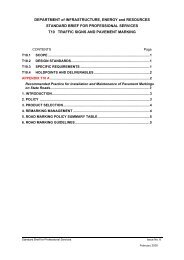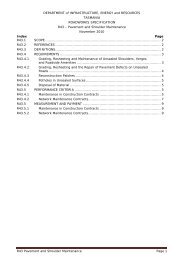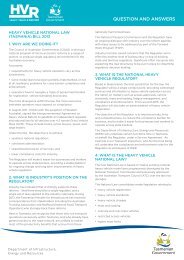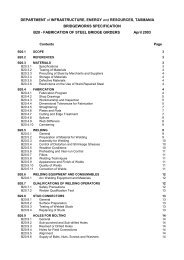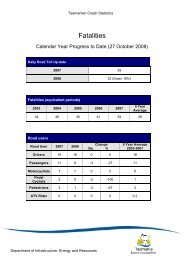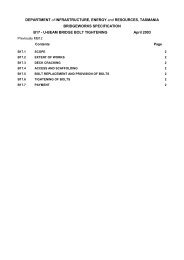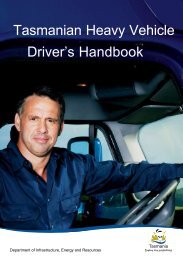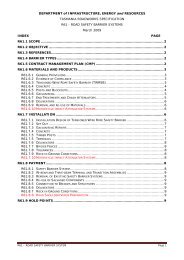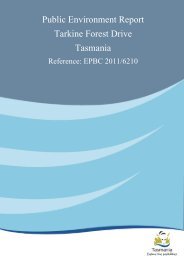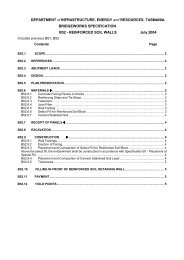Repair Diary Brochure - Transport
Repair Diary Brochure - Transport
Repair Diary Brochure - Transport
- No tags were found...
Create successful ePaper yourself
Turn your PDF publications into a flip-book with our unique Google optimized e-Paper software.
As of 1 July 2012 it is strongly recommendedthat a repair diary is presented for ALL<strong>Repair</strong>able Write Off (RWO) vehicles that havebeen classified as a RWO after 1 July 2012when presenting the vehicle for its tier 1 and3 inspection in Tasmania. Failure to present arepair diary after this date could well result inthe vehicle being failed for inspection.Note: This fact sheet should be read in conjunctionwith the fact sheet on “What you need to do beforeyou purchase a written-off vehicle”.Manufacturer’s guidelinesA damaged vehicle must be repaired in accordance with themanufacturer’s repair instructions, or if unavailable, best industrypractice.The repairer is responsible for obtaining the manufacturer’sguidelines from the vehicle manufacturer or an authoriseddealer of the manufacturer prior to repairing the vehicle.To assist, technical information can be sourced frommanufacturers detailed at the end of this fact sheet.Note: Manufacturers may charge for this material.In some rare cases, a manufacturer will not issue the guidelinesand refer you to an authorised repairer of that vehicle make.In these cases the vehicle should be repaired at an authorisedrepairer as some manufacturers require specialist equipment andknowledge to conduct the repairs.Not all damaged vehicles can be repaired easily or economically.The fact that the vehicle is entered on the Written Off VehicleRegister (WOVR) as a RWO is an indication that the cost torepair the vehicle was greater than the market value of thevehicle and too expensive to repair at commercial rates and toguarantee an ongoing warranty.It is important for a potential buyer of a damaged vehicle tounderstand the risks associated with buying a damaged vehicle,as the scope of repairs may expand quickly beyond the intendedbudget to repair the vehicle, and many unknown factors maycome to light during the repair or inspection process which maylead to the vehicle costing more to repair than was estimated.Risks of not complying with manufacturers’guidelines or best industry practiceIf you repair a vehicle without the guidelines or to best industrypractice, you run the risk of the vehicle being incorrectly repairedand its structural integrity being compromised. This may resultin the area of repair being significantly weaker or stronger thanoriginally intended by the manufacturer, leading to the crashworthinessof the vehicle being compromised and potentiallycatastrophic results if the vehicle is involved in an accident.In this case you will encounter difficulty and additional costsat the time of a structural inspection, and the vehicle will notpass the inspection until the vehicle is correctly repaired andsatisfactory evidence of this is provided.<strong>Repair</strong>ing a damaged vehicleKeeping a crash repair diaryA crash repair diary is a detailed record explaining what repairswere needed on the vehicle, what repair techniques werereferenced and how they were applied during the repair. It alsocontains progress photographs and other material to provideevidence of the nature, extent and activities of the vehicle repair.The diary can be in any form and should chronologically followthe vehicle from purchase, through all repair stages, and end atthe point of presentation for inspection.An example of a crash repair diary is located on the Departmentof Infr astr ucture Ener gy and Resources (DIER) website on:http://www.transport.tas.gov.au/vehicle_ inspections/ambrisPhotographsWhen taking photos, it is best to take a number of photos toensure you describe the process properly. When dismantling avehicle, take photos, when components are being fitted or beingrepaired and refitted, take photos.Photos from the auction house prior to sale are required. Thesemust be obtained as hard copy from the auction house, notdownloaded electronically.Depending on the repair area, and how close the photo is taken, itmay be difficult in interpreting what part of the vehicle the photois showing. In these cases it is best to take a photo from a mediumdistance, and then a close up. Sometimes it helps when scale isintroduced to the photo, so a tape measure can be picturedagainst the subject area to assist.When compiling the crash repair diary, each step should bedocumented with photos and cross referenced with the relevantarea from the manufacturer’s guidelines. A recommended outlineof the crash repair diary should contain a detailed description andphotos:• Before repair work;• During jigging;• Removed panels and pieces;• Replacement panels and pieces;• Method of attachment of replacement panels and pieces; and• Specialised equipment used in the repair.Keeping a crash repair diary when repairing a vehicle createsvisibility of the repair process and you will be less likely to encounterdifficulty when presenting the vehicle for a structural inspection(Tier 1) and WOVR inspection (Tier 3). If the crash repair diary isdone correctly, you may reduce the likelihood of the vehicle beingfailed for inspection or requested to undergo further inspections.Note: The repair diary should be presented in hard copy for itsstructural and WOVR inspections. An electronic copy must also beprovided for the structural inspection, this will be downloaded andforwarded to DIER.What happens if I do not produce arepair diary when presenting my vehiclefor inspection?It is acknowledged that Motor Body Examiner (MBE) cannoteasily be satisfied that the repairs carried out have beenrepaired to the manufacturer’s repair instructions or bestindustry practice, and is justified in failing the vehicle forinspection where they cannot be satisfied as such.



